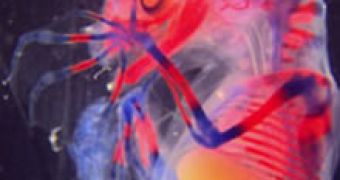Bats are one of the most successful mammals, a fifth of all mammalian species beings bats. They are extremely diverse creatures, but they do have one thing in common: they have wings and fly. Scientists have always been wondering about how bats end up having wings and now the relatively new field of evolutionary developmental biology, or "evo devo" for short, seems to have unraveled the enigma.
Karen Sears and Lee Niswander of the University of Colorado Health Sciences Center in Aurora and their colleagues have compared the wings of the earliest known bat fossil, a 50-million-year-old specimen housed at the American Museum of Natural History in New York, with those of three other species of extinct bats and 10 species of modern bats. They found that in all cases the membranous bat wing is supported by the animal's highly elongated third, fourth, and fifth forelimb digits. What surprised them was to discover that the relative length of these three digits to body size has changed very little over the course of bat evolution. In other words, the bats' wings did not seem to have gradually grown larger and larger, but they have evolved quite suddenly.
This suggests that the evolution of bat wings was due not to changes in the bone genes themselves but to a change in the gene that regulates the expression of these bone genes. To find what gene might have been involved, the team monitored the development of the bat embryo and compared this development to the development of the mouse embryo.
They found that during early development, both bat and mouse forelimb digits grew at about the same rate relative to their overall gestation periods of 120 and 20 days, respectively. However, roughly halfway through gestation, the bat's third, fourth, and fifth forelimb digits suddenly started to grow much faster. In the picture you can see that, at 80 days, the three forelimb digits that will eventually support the bat's wing have already begun to elongate significantly. On the other hand, the same digits in the mouse continued to grow slowly, as did the bat's hind limb digits.
This observation has lead scientists to consider that the sudden growth may be due to a gene that coded a certain protein (called Bmp2) responsible for bone growth. They have found that the expression of this gene was indeed 30% higher in the developing forelimbs of bats than it was in mice. This indicated that what probably prompted the appearance of bats from mouse-like rodents was a mutation in the gene regulating the Bmp2 gene. This mutation, that probably happened around 50 million years ago, has caused an abnormal growth of the forelimbs digits. But these early bats instead of succumbing to such a misfortune and dying off proved to be quite able to adapt. They started to use their overdeveloped fingers as wings, and eventually became some of the most successful mammals on Earth.
Photo Credit: Scott Weatherbee / Memorial Sloan Kettering Cancer Center

 14 DAY TRIAL //
14 DAY TRIAL //